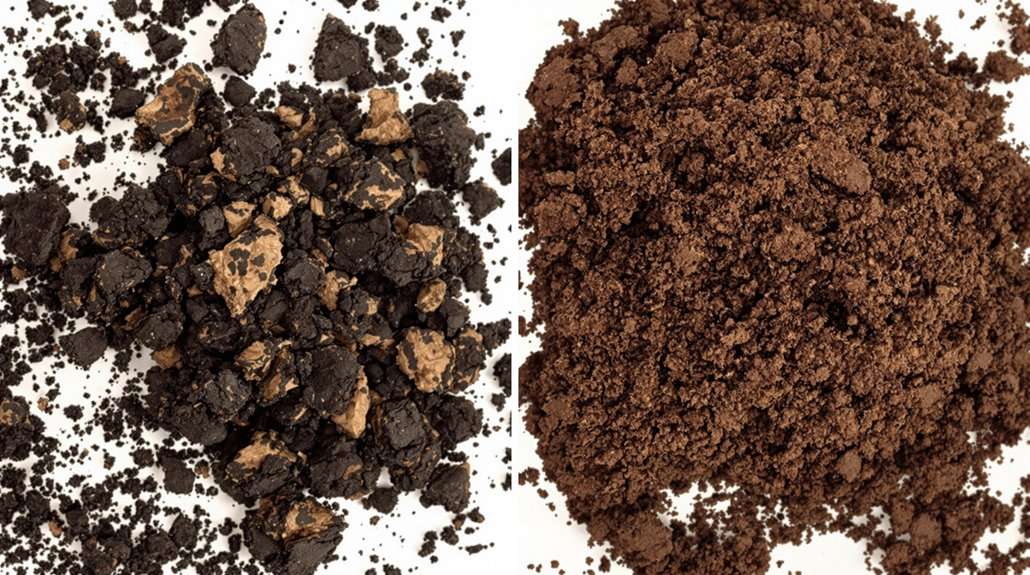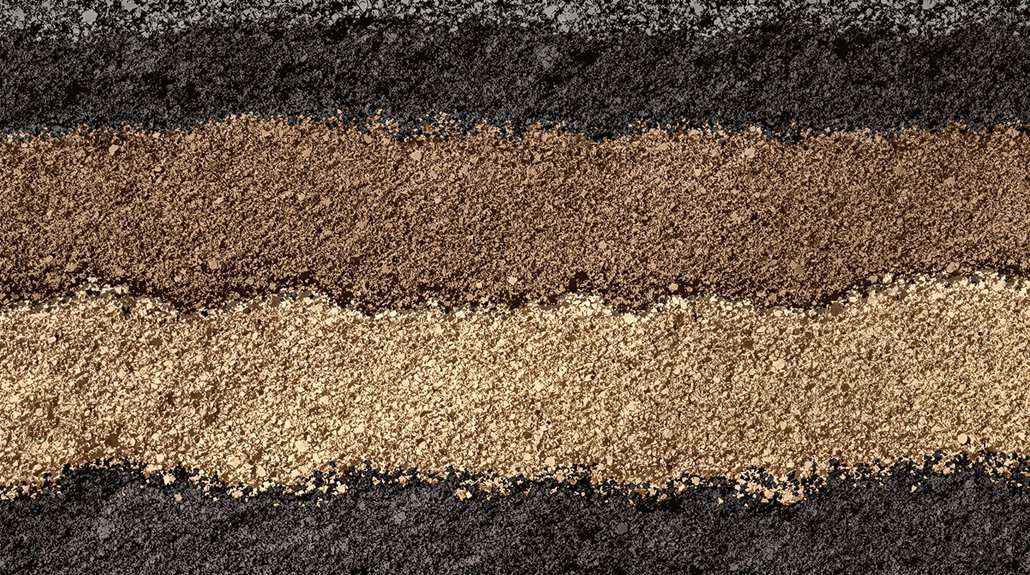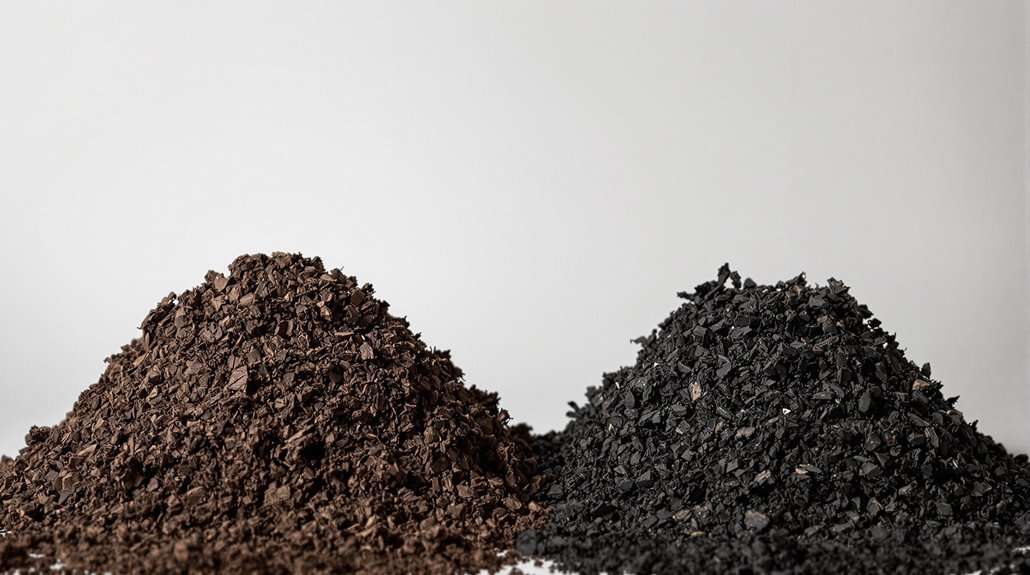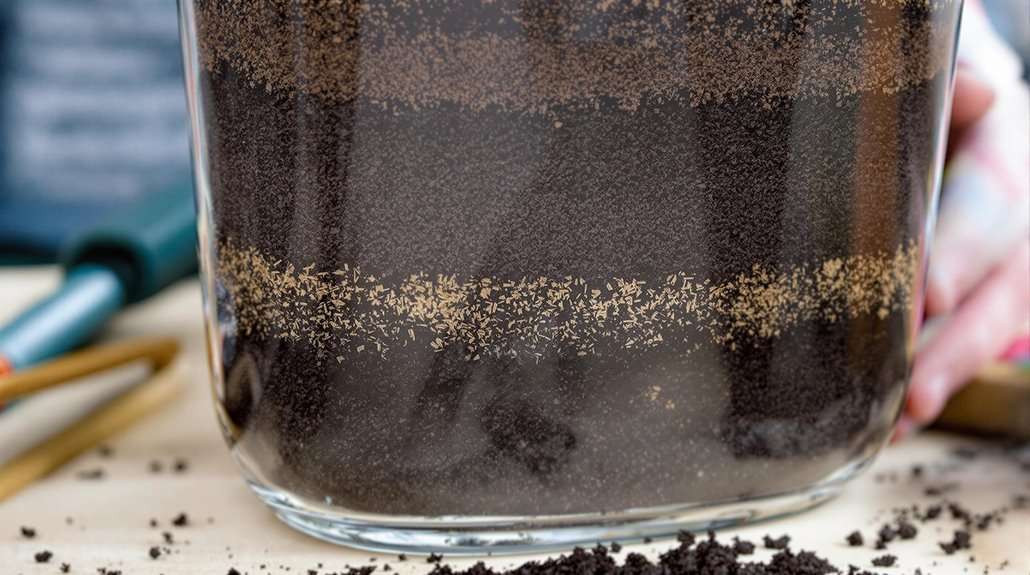Is Compost the Same as Topsoil
No, compost and topsoil aren't the same thing. Topsoil is the naturally formed uppermost layer of earth that contains a mix of mineral particles (sand, silt, clay) with only 2-3% organic matter. Compost, on the other hand, is decomposed organic material made from kitchen scraps, yard waste, and other organic materials, containing up to 90% organic matter. While topsoil serves as your primary growing medium, compost acts as a soil amendment that enriches existing soil with nutrients and beneficial microorganisms. You'll get the best results by combining both, typically using a ratio of one part compost to three parts topsoil. Understanding their distinct properties will help you create ideal growing conditions for your garden.
This post may contain affiliate links. If you make a purchase through these links, I may earn a commission at no additional cost to you. Additionally, portions of this post may be generated using artificial intelligence (AI) technology. While we strive for accuracy, please be aware that AI-generated content may not always be perfect and should be fact-checked when necessary.
The Spatula Scoops
- Compost is primarily decomposed organic matter, while topsoil is the uppermost natural soil layer containing minerals and minimal organic content.
- Topsoil forms naturally over centuries through geological processes, whereas compost can be created in weeks through managed decomposition.
- Compost contains higher concentrations of nutrients and beneficial microorganisms compared to topsoil, making it an excellent soil amendment.
- Compost is approximately 90% organic matter, while topsoil typically contains only 2-3% organic material.
- Both materials serve different purposes: topsoil is the main growing medium, while compost enhances soil quality when mixed with topsoil.
Basic Definitions

Gardeners often confuse compost and topsoil, but they're distinctly different materials. When you're working with compost, you're handling organic matter that's gone through a controlled decomposition process, resulting in a dark, crumbly substance rich in nutrients. This material comes from various sources, including your kitchen scraps, yard waste, leaves, and grass clippings, all of which have been broken down through careful management and heat generation. The transformation of raw materials into compost occurs through a process called humification into humus.
On the other hand, topsoil is nature's own creation – it's the uppermost layer of soil that you'll find in your garden or any natural setting. You'll recognize it as the dark, fertile layer that sits at the surface, containing a mix of organic matter, minerals, and beneficial microorganisms that have developed over time. Unlike compost, which you can create in a matter of months, topsoil forms through natural processes that take years or even centuries. While both materials support plant growth, they serve different purposes: compost acts as a soil amendment to improve existing soil conditions, while topsoil functions as the primary growing medium for your plants.
Composition Differences
The composition of compost and topsoil naturally reflects their distinct origins and purposes. When you're examining topsoil, you'll find it's primarily made up of mineral particles including sand, silt, and clay, with varying amounts of organic matter. In contrast, compost consists almost entirely of decomposed organic materials, such as food scraps, yard waste, and manure, which have been broken down by microorganisms. For optimal plant growth, topsoil should be mixed with a 3-inch layer of additional material.
| Component | Topsoil | Compost |
|---|---|---|
| Primary Materials | Sand, silt, clay | Decomposed organic matter |
| Structure | Dense, varying textures | Loose, crumbly |
| Nutrient Content | Moderate, varies by source | High, consistently rich |
| Moisture Retention | Moderate | Excellent |
You'll notice that while topsoil provides the fundamental growing medium for plants, it often requires enhancement to optimize plant growth. Compost, on the other hand, is naturally rich in nutrients and beneficial microorganisms but isn't suitable as a standalone growing medium. Its loose, organic structure makes it an ideal soil amendment, improving both the fertility and structure of existing soil when mixed together.
Origins and Formation

While topsoil forms naturally over centuries through the gradual accumulation of organic matter and minerals, you'll find that compost can be created in just a few months through controlled decomposition of organic materials. You'll notice that topsoil's development is a complex geological process involving weathering, biological activity, and the slow buildup of organic layers, whereas compost is actively manufactured through human intervention by combining and managing specific organic materials. Whether occurring naturally or through manufacturing, both materials serve essential roles in plant growth, though you can't really substitute one for the other due to their distinct formation processes and resulting properties. Composting can be achieved through various methods including tumblers and piles, which help facilitate the breakdown of organic matter.
Natural Vs Manufactured Formation
Both compost and topsoil emerge through distinct formation processes, with each having natural and manufactured variations. You'll find that natural compost forms when organic materials like food scraps and leaves decompose on their own, while manufactured compost results from intentionally managed decomposition processes. Similarly, natural topsoil develops over time through weathering and organic matter accumulation, whereas manufactured topsoil is created by blending specific ingredients under controlled conditions. High-quality topsoil contains nutrient-rich humus that helps sustain plant growth.
| Process Type | Compost Formation | Topsoil Formation |
|---|---|---|
| Natural | Organic decay of plant matter and food waste | Weathering of rocks and accumulation of organic matter |
| Manufactured | Controlled mixing and decomposition | Blending of soil components and organic materials |
| Time Frame | Weeks to months | Years to centuries (natural), days (manufactured) |
When you're considering either material, it's important to understand that manufactured versions can be tailored to specific needs. You'll notice that manufactured compost often involves accelerated decomposition techniques, while manufactured topsoil typically combines existing soil with additional organic matter and minerals to achieve desired properties.
Time and Development Differences
Understanding the time and development differences between compost and topsoil reveals a stark contrast in their formation processes. While you'll find that topsoil develops naturally over centuries through complex geological and biological processes, compost can be created in a matter of weeks to months under controlled conditions. The distinction lies in how these materials come to be.
When you look at topsoil's development, you'll notice it's a gradual accumulation of organic matter, minerals, silt, clay, and sand that occurs through natural weathering and decomposition. It's a process that can't be rushed, taking decades or even centuries to form a substantial layer. In contrast, you can create compost through an accelerated decomposition process that you're able to manage and control. You'll need to combine nitrogen-rich materials (like kitchen scraps) with carbon-rich materials (such as dried leaves) under specific moisture and aeration conditions. The high biological activity in topsoil makes it essential for healthy plant growth and nutrient absorption. This controlled environment allows beneficial microorganisms to break down organic matter much faster than nature's timeline for topsoil formation, making compost a practical solution for immediate soil enhancement needs.
Nutrient Content Comparison
When you compare compost and topsoil, you'll notice that compost typically contains higher concentrations of key macronutrients like nitrogen, phosphorus, and potassium, making it an excellent natural fertilizer for your plants. While topsoil usually contains 2-3% organic matter, compost can contain up to 50% organic matter, which leads to considerably higher microbial activity and nutrient cycling. Your plants will benefit from this enriched environment, as the increased microbial populations in compost help break down organic materials into forms that roots can easily absorb. Combining these materials creates ideal growing conditions by balancing the bulk structure of topsoil with the nutrient-rich properties of compost.
Macronutrient Levels and Benefits
The nutrient content between compost and topsoil differs considerably, with compost packing a higher concentration of essential macronutrients. When you're looking at nitrogen content, you'll find that compost consistently provides higher levels than topsoil, which directly supports your plants' leaf growth and overall health. Compost's microbial activity makes this nitrogen readily available to your plants. Regular soil pH testing is crucial for monitoring nutrient availability and absorption by plants.
You'll notice similar patterns with phosphorus and potassium levels. Compost delivers higher concentrations of phosphorus, which is vital for root development and flower formation in your garden. The potassium content in compost also surpasses that of typical topsoil, helping your plants build resistance to disease and maintain vigor under stress conditions.
When you combine compost with topsoil, you're creating a peak growing environment. The compost acts as a powerful soil amendment, enhancing the topsoil's existing nutrient profile. Through proper mixing, you'll achieve balanced macronutrient levels that provide your plants with the essential elements they need for robust growth. This combination guarantees your soil can support healthy plant development throughout the growing season.
Organic Matter Percentages
Major differences in organic matter content distinguish compost from topsoil, with compost containing up to 90% organic materials while topsoil typically holds much less. You'll find that compost's high organic matter percentage makes it an excellent source of nutrients and beneficial microorganisms, which actively improve soil structure and fertility.
When you're comparing the two materials, you'll notice that topsoil's organic content is considerably lower, as it's primarily composed of mineral particles mixed with some organic matter in the form of humus. While topsoil provides essential minerals and serves as a foundation for plant growth, it often requires additional amendments to match compost's nutrient-rich profile. This makes compost an excellent choice for slow-release nutrients that support sustainable plant health over time.
The organic matter in both materials serves different primary functions. In compost, it's concentrated to deliver maximum nutritional benefits and improve soil structure, while in topsoil, it works alongside minerals to create a stable growing medium. You'll find that combining both materials often yields the best results, as topsoil provides the necessary bulk and structure while compost contributes the rich organic matter that promotes healthy plant growth.
Microbial Activity Differences
Microbial activity serves as a key differentiator between compost and topsoil, with compost hosting considerably higher concentrations of beneficial microorganisms due to its decomposition process. When you're working with compost, you'll find it's teeming with microorganisms that actively break down organic matter, releasing essential nutrients into the soil. This controlled decomposition process creates an environment that's remarkably richer in beneficial bacteria and fungi compared to regular topsoil.
Screened topsoil typically offers better microbial conditions since it's free from debris that could inhibit healthy bacterial growth. While topsoil naturally contains its own diverse microbial community, it typically doesn't match the intensity of microbial activity found in compost. You'll notice that topsoil's microbial population varies based on its organic matter content and environmental conditions. However, you can enhance topsoil's microbial activity by incorporating compost.
- Compost acts as a microbial powerhouse, introducing concentrated populations of beneficial organisms
- Topsoil provides the foundational ecosystem for microbial life but at lower concentrations
- Combining both materials creates a prime environment for sustained microbial activity
The relationship between these two materials isn't competitive but complementary. When you blend compost with topsoil, you're creating an environment that maximizes the benefits of both materials' microbial communities.
Garden Applications

Both compost and topsoil play essential roles in successful gardening, but they're most effective when used strategically for different applications. You'll find that topsoil works best as your foundation material, especially in raised beds where you need to build up volume, while compost serves as an enriching amendment to boost soil fertility and structure. High-quality compost should have an earthy aroma that indicates proper maturity.
For new garden beds, you'll want to incorporate 2 to 4 inches of compost into the top 8 to 12 inches of existing soil, creating an ideal growing environment for your plants. In established gardens, you can maintain soil health by adding 1 to 2 inches of compost annually. When it comes to lawn care, you can spread a thin layer of compost after aerating or dethatching to improve soil structure and nutrient content.
If you're working with containers, don't use compost alone as it can lead to compaction and drainage issues. Instead, create a balanced mix by combining topsoil with compost and other materials like coco coir. For sustainable gardening practices, you can also use compost as a protective mulch layer to retain moisture and suppress weed growth.
Soil Enhancement Methods
Effective soil enhancement requires a strategic combination of topsoil and compost to create ideal growing conditions. You'll want to mix these materials properly, incorporating compost into the top 6 to 12 inches of your existing soil while adding topsoil to achieve the right depth for your garden beds. When you're enhancing your soil, it's essential to understand that topsoil provides the foundation while compost enriches it with vital nutrients. Conducting a visual soil inspection will help ensure you're using quality materials that appear dark and crumble easily.
Here's what you'll need to focus on for successful soil enhancement:
- Mix one part compost to three parts topsoil for new garden beds, ensuring thorough integration for best plant growth
- Apply compost annually to maintain soil fertility, preferably in spring or fall when you're preparing your beds
- Layer topsoil to a depth of 8-12 inches, incorporating compost throughout rather than just on the surface
Remember that quality matters greatly when selecting your materials. You'll achieve the best results by using high-grade topsoil that matches your specific gardening needs – whether that's clay-based for trees, sandy for flowers, or loamy for vegetables. Regular maintenance with annual compost additions will help sustain your soil's health and productivity over time.
Common Misconceptions

While understanding soil enhancement methods is important, it's necessary to clear up several widespread misconceptions about compost and topsoil. You might think these materials are interchangeable, but they serve distinct purposes in your garden. Topsoil provides the foundation for your landscaping projects, while compost acts as an amendment to enhance soil quality.
You'll often hear that topsoil naturally contains sufficient organic matter, but this isn't always true. In fact, your topsoil may be quite depleted, especially if it's been subject to erosion or extensive cultivation. Similarly, you shouldn't assume all compost products are created equal – their quality varies greatly based on the decomposition process and source materials.
Don't fall into the trap of thinking you can use compost as fill dirt or a complete topsoil replacement. Instead, you'll want to use them together for ideal results. While topsoil forms the base layer of your garden, compost improves its structure by adding essential nutrients and organic matter. The two materials work in tandem to create a healthy growing environment for your plants. Additionally, using airtight containers, such as food grade glass jars, can help in storing and preserving compost and topsoil.
Quality Indicators
Gardeners need clear ways to identify quality in both topsoil and compost materials. When you're examining topsoil, look for a soft texture that's free of rocks and debris, with a dark color indicating high organic content. You'll want to make certain it has a balanced mix of clay, sand, and silt, which creates ideal growing conditions for your plants.
Quality compost, on the other hand, should be fully decomposed with a chocolate-brown color and fine, crumbly texture. You shouldn't see any recognizable pieces of organic material, and it should have an earthy smell without any unpleasant odors.
- Check the moisture content by squeezing a handful – good topsoil or compost should hold together without dripping water
- Look for uniform color and texture throughout the material, avoiding products with obvious layering or inconsistencies
- Test the smell – both materials should have a fresh, earthy aroma without any sour or ammonia-like scents
When you're purchasing either material, it's important to source from reputable suppliers who can verify their quality control measures. Remember that while topsoil provides the foundation, compost serves as an enriching amendment that'll improve your soil's overall structure and fertility.
Best Usage Practices

Understanding how to properly use both compost and topsoil will maximize your garden's success. When creating new garden beds, you'll want to blend 2-4 inches of compost into the top 12 inches of soil, while incorporating topsoil to improve drainage and moisture retention. For existing gardens, add 1-2 inches of compost annually to maintain soil health.
For the best results, you'll need to combine these materials strategically. Mix compost with topsoil to achieve about 5% organic matter content, which creates an ideal growing environment. When working with containers, don't use topsoil alone, as it can lead to compaction issues. Instead, incorporate compost into your potting mix to enhance water retention and nutrient availability.
For lawn care, you can spread a half-inch layer of compost after aerating or dethatching. When building raised beds, create a balanced mix of topsoil, compost, and other amendments. Remember to maintain your soil's health through regular additions of compost while using topsoil for structural support and proper drainage. This combination will guarantee your plants have the best foundation for growth.
Frequently Asked Questions
Can Compost Be Harmful to Pets if They Accidentally Eat It?
Yes, compost can be dangerous for your pets if they eat it. When pets consume compost, they're exposed to harmful bacteria, molds, and potential toxins from decomposing organic materials. You'll need to watch for symptoms like vomiting, diarrhea, and lethargy if your pet ingests compost. To protect your pets, you should store compost in secure containers, fence off composting areas, and seek immediate veterinary care if ingestion occurs.
How Long Does Compost Remain Effective After Mixing With Topsoil?
Your compost will remain effective for several years after mixing with topsoil, though its impact varies based on quality and conditions. You'll see the strongest benefits in the first 2-3 years as nutrients gradually release into the soil. The organic matter eventually transforms into stable humus, which continues to improve soil structure. Regular monitoring and occasional reapplication will help you maintain ideal soil health long-term.
Does Adding Compost Affect the Ph Level of Existing Topsoil?
"You reap what you sow" rings especially true when it comes to compost's effect on your soil's pH. When you add compost to your topsoil, it'll definitely impact the pH level, but how much depends on your compost's makeup. Well-balanced compost typically helps stabilize soil pH around neutral (7.0). You'll find that compost acts as a natural buffer, preventing dramatic pH swings while gradually improving your soil's overall health.
Can Winter Freezing Damage the Beneficial Properties of Compost?
You don't need to worry about winter freezing damaging your compost's beneficial properties. While freezing temperatures will slow down microbial activity, they won't destroy the nutrients or organic matter in your compost. The microorganisms simply become dormant and will reactivate when temperatures warm up. To maintain ideal conditions, you'll want to cover your compost pile during winter to retain heat and moisture, allowing for continued slow decomposition.
Should Compost Be Mixed Differently for Indoor Versus Outdoor Plants?
You'll need to adjust your compost mixing techniques between indoor and outdoor plants. For outdoor use, you can mix compost more liberally with existing soil, typically using a 1:3 ratio of compost to soil. Indoor plants require a more careful approach – stick to a 1:5 ratio of compost to potting mix, as too much compost can lead to waterlogging in containers. Indoor mixes should also be thoroughly aged and screened to prevent pest issues.





